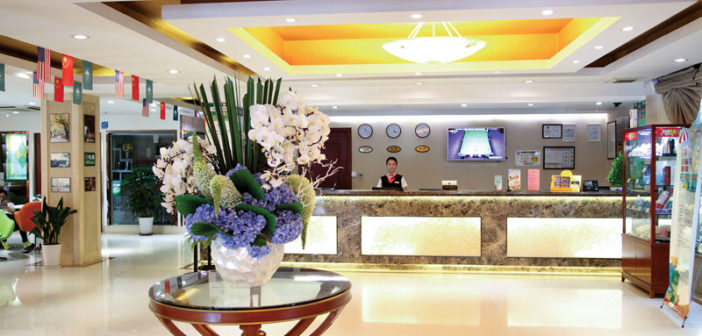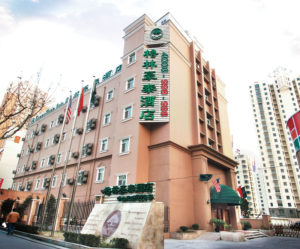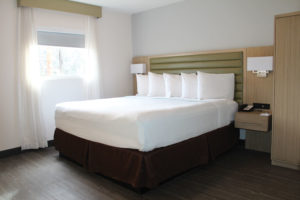SHANGHAI—The GreenTree Hospitality brand has been in existence for nearly 15 years. Over the course of its existence, the company itself has grown to more than 2,400 properties in two countries. While the original GreenTree company has gone public, its extension in the United States, a private and separate entity, GreenTree Hospitality Group Inc., has grown its portfolio to nearly 10 properties in two states. United by a commonality of ownership and mutual support, both entities have an invested interest in seeing the GreenTree brand thrive and expand its reach beyond its current borders.
Alex Xu founded the GreenTree brand in 2004, after exiting the homebuilding industry in Southern California. “He invested part of the proceeds from the sale of residential lots to public homebuilders in a start-up hospitality venture in China (along with a small group of original investors),” said Kevin Brooks, managing director of GreenTree Hospitality Group Inc., which is privately owned and not a part of GreenTree Hospitality Group Ltd. GreenTree’s founder initially intended to step away from the company by taking on a more passive role; however, soon thereafter, he became GreenTree’s president and CEO.
The first Asia-based GreenTree Inn opened for operation in 2004. Throughout its lifespan, the overarching GreenTree brand has gone through various market cycles, including the global economic downturn and liquidity crisis in 2008—and not only survived, but thrived, according to Brooks. “This is attributed to the effective management and operational systems the company has developed, along with the vision of the company’s CEO,” he said. While the Great Recession hit other global economies hard, being based in China, GreenTree continued to roll out new brands in its portfolio.
“Our strong and supportive franchise platform and disciplined return-driven [strategy]enable franchisees to generate highly attractive investment returns, which we believe is both a strong attraction for potential franchisees and a strong incentive for existing franchisees to open multiple hotels,” Xu said.
GreenTree in 2008 founded GreenTree Alliance (now GT Alliance), which offers “unique hotels in desirable locations to deliver individualized experiences with distinctive decor and furnishings,” according to GreenTree. In 2012, GreenTree Eastern, a brand of premium boutique hotels, rolled out. The following year, Vatica, GreenTree’s environmentally friendly brand, launched. In 2016, GreenTree delivered Shell, a brand geared toward young professionals, travelers and college students in major urban centers. Then, in 2017, several mid- to upscale brands launched: Gme, Gya and VX.
“We believe that our ability to open new franchised hotels and introduce new brands depends primarily on our brand recognition and reputation, the results of our overall operations in general and the success of our current franchised-and-managed hotels,” Xu said. “Other competitive factors include marketing support, member program, efficiency of our central reservation system, and our ability to provide systems and support to assist franchisees to operate their hotels cost effectively.”
In total, as of Q2 2018, under all eight of its brands, GreenTree Hospitality Group Ltd. has 2,434 hotels with 201,275 rooms across China.
“We intend to diversify our brand portfolio and mix of hospitality offerings to cover market segments from economy to mid- to upscale markets,” he said. “We believe there is room for GreenTree to create more new brands in the future to meet specific tastes and price range demands from our guests.”
Going public
GreenTree Hospitality Group Ltd. filed for an IPO in early March 2018 and began trading shares under the symbol GHG on the New York Stock Exchange (NYSE) on March 27. (GreenTree Hospitality Group Inc., which operates in the United States under a franchising agreement, is a separate entity, and even though it’s owned by Xu, it’s not part of the publicly traded company.) Since its IPO, GreenTree has seen growth—an increase in opened properties, cities it’s operating in and overall supply pipeline.
“GreenTree has been building its platform to make sure everybody wins,” Xu said. “First and foremost, our franchisees, because they are the ones who are working really hard to provide a great product and service to our guests; secondly, our guests, who will enjoy a great stay experience at the most reasonable price; thirdly, our employees, who will be nurtured and grow in our platform; and, as a result, the shareholders and all other stakeholders are going to be greatly benefited from this exercise. This is our value and culture, and [we’ve been] sticking to this from day one.”
In Q2 2018, according to an earnings call, GreenTree opened 104 new properties: 68 in the midscale segment; five in the business to mid-to-upscale segment; and 31 in the economy segment. “In Q2 2018, we opened 97 hotels, while for full-year 2018, we opened 425,” said Jasmine Xin Yue Geffner, CFO of GreenTree, during the call. “Therefore, you could see that we accelerated our hotel openings in Q2 2018, as well as the first half of 2018.” Of these properties, the hospitality company opened seven in tier-one cities; 22 in tier-two cities; and the remaining 75 in other cities throughout China.
“We now cover 267 cities, up from 263 cities at the end of last year,” Xu said during the call. “We believe opening hotels in new cities is very important to GreenTree’s growth, especially in tier two and other cities in China. We believe this will further enhance our brand image in those new cities and will attract new business and leisure travelers from those cities.”
GreenTree added 31 hotels to its total pipeline in Q2 2018. Its pipeline of new hotels increased from 306 as of December 31, 2017, to 477 as of June 30, 2018, an increase of approximately 56%.
Geographically, the hospitality group has plans to grow its portfolio—in China, but elsewhere, too. “We also aim to selectively expand our presence into overseas markets where we see strong demand and growth prospects,” Xu said. “Currently, our target markets include countries well-traveled by Chinese travelers, such as Southeast Asia, Australia, Japan and Korea, which we consider a natural extension of our operations in China.”
The hospitality group attributes some of its success to its loyalty program, which, unlike many of its competitors, is a paid membership model. “[The program] offer members many benefits (lower rates, waiving of certain fees, upgrades, special offers, etc.),” Brooks said. “The Asia operation also has an online mall that members can utilize, while the U.S. program is a cashback program (members can receive 3% cashback, make a charitable contribution, or receive a 5% voucher toward future stays).” GreenTree has roughly 24 million individual loyalty members and more than 930,000 corporate members.
“Our strong brand and direct relationship with so many valued customers allowed us to sell direct, instead of relying on selling through OTAs, which is more expensive,” Xu said during the call.
In Q2 2018, GreenTree sold approximately 95% of its room nights through its direct channels.
GreenTree is partly relying on M&A opportunities for additional growth means, preferring branded targets with geography “complementary to our existing hotel portfolio,” he said during the call. “We believe the right acquisition as well as the smallest post-acquisition integration will help accelerate our planned long-term expansion.”
As for the coming year, GreenTree’s founder is optimistic. “We continue to execute our dual strategy of organic growth and acquisitions in China,” he said. “You should continue to see strong hotel openings, healthy revenue growth and improving margins.”
U.S. operations
Based in Scottsdale, AZ, GreenTree Hospitality Group Inc. launched in 2015 with its first property: GreenTree Inn & Suites Phoenix Sky Harbor. Even though the U.S. operation is in its infancy, GreenTree’s goal is to focus on providing a “low-cost, high-value franchise model, given the changing hospitality environment,” Brooks said. “We want our franchise properties to embrace their local market and get away from the one-size-fits-all mentality. It is an entrepreneurial-focused platform, designed for engaged owners who focus on their business and their guests.”
GreenTree’s U.S. franchise model is closer to the traditional franchise and support model, without the management component to it, which isn’t necessarily a basic need for hoteliers, he said.
In the U.S., GreenTree offers guests a single brand, GreenTree Inn, which has several brand extensions: GreenTree Inn, GreenTree Inn & Suites and GreenTree Boutique.
“The single U.S. brand and limited segmentation is a differentiator versus the mega brands that have multiple brands overlapping market segments (properties within the company competing against other branded properties in the same market and often in the immediate area),” Brooks said.
In its portfolio, GreenTree has nine properties in the country in two states: Arizona and California. Arizona’s properties include GreenTree Inn Flagstaff, GreenTree Inn & Suites Florence, GreenTree Inn & Suites Mesa, GreenTree Inn & Suites Phoenix, GreenTree Inn Pinetop, GreenTree Inn Prescott Valley, and GreenTree Inn Sedona. California’s properties include GreenTree Inn & Suites Alhambra and GreenTree Pasadena Inn.
“We never forget the amount of work, capital and effort our franchisees put into their hotels on a daily basis, so that mentality is where it all starts,” he said.
In the U.S., GreenTree is looking for growth opportunities in a variety of areas. It would also like to expand from the Southwest, eventually becoming a countrywide presence.
“Strictly speaking for the U.S. operation, we are constantly on the lookout for strategic partnerships, acquisitions and collaboration opportunities,” Brooks said. “The key to evaluating these opportunities is the impact on all the stakeholders.” HB
 2004: The first Asia-based GreenTree Inn opens for operation.
2004: The first Asia-based GreenTree Inn opens for operation.
2008: GT Alliance Hotel opens for operation. (The GreenTree Alliance Hotel brand changed to GT Alliance Hotel in 2018.)
2009: The 500th GreenTree Inn opens its doors.
2012: GreenTree Eastern Hotel opens for operation.
2013: Vatica Hotel opens for operation.
2015: The first U.S.-based GreenTree Inn opens for business in Phoenix, AZ.
2016: Shell Hotel opens.
2017: Three brands are established: Gme Hotel, Gya Hotel and VS Hotel; The first U.S.-based GreenTree Inn franchised property debuts in Prescott Valley, AZ.
2018: GreenTree Asia, a foreign entity operating in China, becomes a publicly traded company on the New York Stock Exchange (NYSE).




